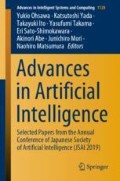Abstract
This is an extension from a selected paper from JSAI2019. Computerized adaptive testing (CAT) estimates an examinee’s ability sequentially and selects test items that have the highest accuracy for estimating the ability. However, conventional CAT selects the same items for examinees who have equivalent ability. As described herein, we propose CAT that minimizes item exposure and which adaptively selects different items for examinees of equal ability, while retaining accuracy. This paper presents the method’s effectiveness using simulation data and actual test data.
Access this chapter
Tax calculation will be finalised at checkout
Purchases are for personal use only
References
Adema, J.J.: Implementations of the branch-and-bound method for test construction problems. Methodika 6(2), 99–117 (1992)
Baker, F.B., Kim, S.H. (eds.): Item Response Theory: Parameter Estimation Techniques. CRC Press, Boca Raton (2004)
Choi, S.W., Moellering, K.T., Li, J., van der Linden, W.J.: Optimal reassembly of shadow tests in CAT. Appl. Psychol. Measur. 40(7), 469–485 (2016)
Ishii, T., Songmuang, P., Ueno, M.: Maximum clique algorithm and its approximation for uniform test form assembly. IEEE Trans. Learn. Technol. 7(1), 83–95 (2014)
Kingsbury, G.G., Zara, A.R.: Procedures for selecting items for computerized adaptive tests. Appl. Measur. Educ. 2(4), 359–375 (1989)
Lord, F., Novick, M.R.: Statistical Theories of Mental Test Scores. Addison-Wesley, Boston (1968)
Recruit: Synthetic personality inventory (SPI). http://www.spi.recruit.co.jp/
Ueno, M.: An extension of the IRT to a network model. Behaviormetrika 29(1), 59–79 (2002)
Ueno, M.: Adaptive testing based on Bayesian decision theory. In: The Proceedings of the 16th International Conference on Artificial Intelligence in Education, pp. 712–716 (2013)
Ueno, M., Miyazawa, Y.: Pobability based scaffolding system with fading. In: The Proceedings of the 16th International Conference on Artificial Intelligence in Education, pp. 492–503 (2015)
Ueno, M., Miyazawa, Y.: IRT-based adaptive hints to scaffold learning in programming. IEEE Trans. Learn. Technol. 11(4), 415–428 (2018)
Ueno, M., Miyazawa, Y.: Uniform adaptive testing using maximum clique algorithm. In: The Proceedings of the 20th International Conference on Artificial Intelligence in Education, pp. 482–493 (2019)
Ueno, M., Songmuang, P.: Computerized adaptive testing based on decision tree. In: 2010 10th IEEE International Conference on Advanced Learning Technologies, pp. 191–193. IEEE (2010)
van der Linden, W.J., Glas, C.A.W. (eds.): Elements of Adaptive Testing. Springer, Heidelberg (2010)
van der Linden, W.J., Reese, L.M.: A model for optimal constrained adaptive testing. Appl. Psychol. Measur. 22(3), 259–270 (1998)
van der Linden, W.J., Veldkamp, B.P.: Constraining item exposure in computerized adaptive testing with shadow tests. J. Educ. Behav. Stat. 29(3), 273–291 (2004)
Way, W.D.: Protecting the integrity of computerized testing item pools. Educ. Measur. Issues Pract. 17, 17–27 (1998)
Author information
Authors and Affiliations
Corresponding author
Editor information
Editors and Affiliations
Rights and permissions
Copyright information
© 2020 Springer Nature Switzerland AG
About this paper
Cite this paper
Miyazawa, Y., Ueno, M. (2020). Computerized Adaptive Testing Method Using Integer Programming to Minimize Item Exposure. In: Ohsawa, Y., et al. Advances in Artificial Intelligence. JSAI 2019. Advances in Intelligent Systems and Computing, vol 1128. Springer, Cham. https://doi.org/10.1007/978-3-030-39878-1_10
Download citation
DOI: https://doi.org/10.1007/978-3-030-39878-1_10
Published:
Publisher Name: Springer, Cham
Print ISBN: 978-3-030-39877-4
Online ISBN: 978-3-030-39878-1
eBook Packages: Intelligent Technologies and RoboticsIntelligent Technologies and Robotics (R0)

